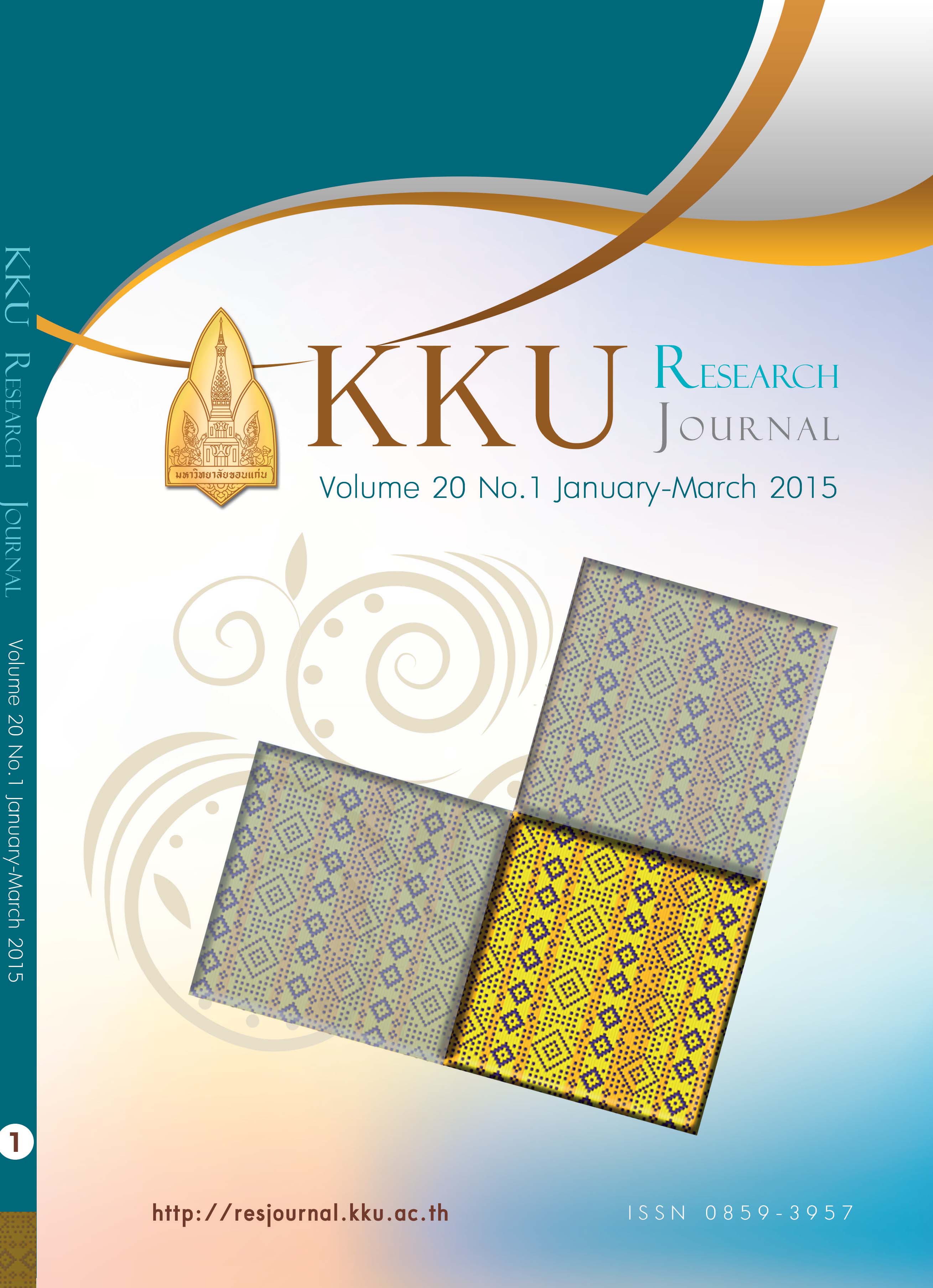Analysis of capsaicin and dihydrocapsaicin from sweet-to-very hot chilli peppers using an ultrasound-assisted extraction followed by RP-HPLC-PDA
Main Article Content
Abstract
In the present study, the optimal conditions of an ultrasound assisted extraction for both capsaicin and dihydrocapsaicin in hot chilli samples were developed. The parameters affecting the yield of the capsaicinoids such as extraction solvents (methanol, ethanol, acetonitrile and water), solvent to sample ratio, extraction temperature and extraction time were investigated. The capsaicinoid extracts were analyzed by reversed phase-HPLC with photodiode array detector (RP-HPLC-PDA). The optimum extraction conditions consist of 20 mL of 80% (v/v) methanol and water as the extraction solvents and 20 min extraction time at 50ºC. The method was applied to determine seven varieties of sweet-to-very hot chilli peppers cultivated. The concentration of the capsaicinoids ranging from 573.44-15220 µg/g was widely found in these samples.
Article Details
References
[2] Giuffrida, D., Dugo, P., Torre, G., Bignardi, C., Cavazza, A., Corradini, C. Characterization of 12 Capsicum varieties by evaluation of their carotenoid profile and pungency determination. Food C h e m . 2013;140: 794–802.
[3] Huang, X. F., Xue, J. Y., Jiang, A. Q., Zhu, H. L. Capsaicin and its analogues:structure-activity relationship study. Current Med Chem. 2013; 20: 2661–2672.
[4] Garcia-Salas P., Morales-Soto A., Segura-Carretero A., Fernández-Gutiérrez A. Phenolic compound extraction systems for fruit and vegetable samples. Molecules. 2010; 15: 8813-8826.
[5] Barbero G.F., Palma M., Barroso C.G. Pressurized liquid extraction of capsaicinoids from peppers. J. Agric. Food. Chem. 2006; 54: 3231−3236.
[6] Chinn S.M., Sharma-Shivappa R. R., Cotter L. J. Solvent extraction and quantification of capsaicinoids from Capsicum chinense. Food Bioprod. Process. 2011; 89: 340–345.
[7] Davis CC. B., Markey C. E., Busch M. A., Busch K. W. Determination of capsaicinoids in Habanero peppers by chemometric analysis of UV spectral data. J. Agric. Food. Chem. 2007;55: 5925−5933
[8] Kozukue N., Han J. S., Kozue E.,Lee S. J., Kim J.A., Lee K. R., Levin C., et. al.. Analysis of eight capsaicinoids in peppers and pepper-containing foods by high-performance liquid chromatography and liquid chromatography−mass spectrometry. J . A g r i c . F o o d . Chem. 2005; 53: 9172−9181.
[9] Nwokem C.O., Agbaji E.B., Kagbu J.A., E.J. Ekanem. Determination of capsaicin content and pungency level of five different peppers grown in Nigeria. NY Sci. J. 2010; 3[9): 17-21.
[10] Pena-Alvarez A., Ramírez-Maya E., Alvarado-Suárez L. Analysis of capsaicin and dihydrocapsaicin in peppers and pepper sauces by solid phase microextraction-gaschromatography–mass spectrometry. J. Chromatogr. A. 2009; 1216: 2843–2847.
[11] Perucka I., and Oleszek W. Extraction and determination of capsaicinoids in fruit of hot pepper Capsicum annuum L . by spectrophotometry and high-performance liquid chromatography. Food Chem.2000;71:287-291.[12)Kirschbaum-Titze P., C. Hiepler, E. Mueller-Seitz, M. Petz. Pungency in Paprika [Capsicum annuum] Decrease of Capsaicinoid Content Following Cellular Disruption. J. Agric. Food Chem. 2002; 50: 1260-1263.
[13] Contreras-Padilla M., E.M. Yahia. Changes in Capsaicinoids during Development, Maturation, and Senescence of Chile Peppers and Relation with Peroxidase Activity. J. Agric. Food Chem. 1998; 46 : 2075-2079.
[14] Santamaria R.I., M.D. Reyes-Duarte, E. Barzana, D. Fernando, F.M. Gama, M. Mota, A. Lopez-Munguia. Selective Enzyme-Mediated Extraction of Capsaicinoids and Carotenoids from Chili Guajillo Puya [Capsicumannuum L.] Using Ethanol as Solvent. J. Agric. Food Chem. 20004; 8: 3063- 3067.
[15] Chanthai S . Juaugsamoot J.,Ruangviriyachai C., Techawongsa-tien S. Determination of capsaicin and dihydrocapsaicin in some chilli varieties using accelerated solvent extraction associated with solid-phase extraction methods and RP-HPLC-Fluorescence. E-J. Chem. 2012; 9[3): 1550-1561.
[16] Barbero G.F., Palma M., Barroso C.G. Determination of capsaicinoids in peppers by microwave-assisted extraction–high performance liquid chromatography with fluorescence detection. Anal. Chim. Acta. 2006; 578: 227–233. [17)Karnka R., M. Rayanakorn, S. Watanesk, Y. Vaneesorn, Optimization of High-Performance Liquid Chromatographic Parameters for the Determination of Capsaicinoid Compounds Using the Simplex Method. Anal. Sci. 2002; 18: 661-665.
[18] Korel F., N. Bagdatlioglu, M.O. Balaban, Y. Hisil, Ground Red Peppers: Capsaicinoids Content, Scoville Scores, and Discrimination by an Electronic Nos. J. Agric. Food Chem. 2002; 50: 3257-3261.
[19] M.D. Luque de Castro, L.E. Garcia-Ayuso. Soxhlet extraction of solid materials: an outdated technique with a promising innovative future. Anal. Chi. Act. 1998; 369: 1-10.


